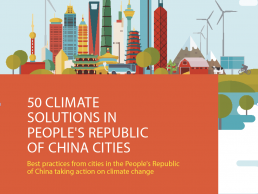Featured in

50 Climate Solutions of Cities in the People's Republic of China
50 climate solutions from cities in the People's Republic of China
By Amy Leung,Director General, East Asia Department, Asian Development Bank
Developing Asia ́s cities are crucial in coming forth with innovative solutions to protect them against climate change and can set the pace for national policies
The world is undergoing the largest wave of urban growth in history, with more people living in cities now than in rural areas. This is nowhere more visible than in developing Asia, where existing conurbations and new towns grow with incredible speed. Asian cities are expected to contribute to two -thirds of the world ́s urban population growth by 2020.
Greenhouse gas (GHG) emissions, especially carbon dioxide, are growing with this trend of urbanization and have a significant impact on health, water resources, agriculture, fisheries, and tourism. While the region is particularly exposed to climate risk, due to its geography, low incomes, poor infrastructure, and insufficient adaptive capacity exacerbate climate vulnerability further. Rising risk and vulnerability jeopardize the hard-won socioeconomic gains of the recent years and continued economic growth. It is estimated that climate change could cut developing Asia ́s GDP by more than 10% by 2100 if no action is taken.
By taking the lead on low-carbon development, cities have the opportunity to turn the wheel around, engage in an important dialogue about sustainable development, directly address local issues, implement environmental improvement measures and contribute to the reduction of greenhouse gas emissions.
Directly experiencing the consequences of climate change, the best solutions often come from cities. Sharing good practice examples may inspire other cities in their quest for further innovation and becoming climate-proof while ensuring further economic development. Putting forth low-carbon development strategies also allows cities to position themselves as major players in climate change mitigation and set an example for the development of national emissions reduction policies.
Facts


